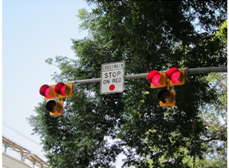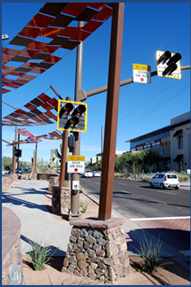U.S. Department of Transportation
Federal Highway Administration
1200 New Jersey Avenue, SE
Washington, DC 20590
202-366-4000

U.S. Department of Transportation
Federal Highway Administration
In this issue:
Spotlight on Proven Countermeasures: Pedestrian Hybrid Beacon.
Pedestrian Hybrid Beacon Case Study: Tucson, AZ
Pedestrians and Bicyclists to be Included in New Traffic Monitoring Guide
The Moving Ahead for Progress in the 21st Century Act (MAP-21) was enacted July 6, 2012. New program requirements became effective October 1, 2012. As reported in the Fall 2012 edition of this newsletter, MAP-21 has few new provisions directly affecting pedestrians, and pedestrian projects remain broadly eligible across the Federal-aid highway program.
The Transportation Alternatives Program (TAP) authorized under Section 1122 of MAP-21 (23 U.S.C. 213(b), 101(a)(29)) provides funding for programs and projects defined as transportation alternatives, including on- and off-road pedestrian and bicycle facilities, infrastructure projects for improving non-driver access to public transportation and enhanced mobility, community improvement activities, and environmental mitigation; recreational trail program projects; safe routes to school projects; and projects for the planning, design or construction of boulevards and other roadways largely in the right-of-way of former Interstate System routes or other divided highways.
FHWA's MAP-21 website posts guidance as it becomes available, see https://www.fhwa.dot.gov/map21/guidance/.
In FY 2012, the States obligated $853.8 million for pedestrian and bicycle projects, a new annual high (excluding extra funds made available under the American Recovery and Reinvestment Act). Fiscal year 2013 funding information is available at https://www.fhwa.dot.gov/legsregs/directives/ (look under Recent Additions).
As a reminder, Federal responsibility for the Safe Routes to School Program has been transferred from the Office of Safety to the Office of Planning, Environment, and Realty. FHWA continues to have close coordination between these offices.
As mentioned in the Winter 2012 edition of this newsletter, FHWA is promoting the use of 9 proven crash countermeasures including three specifically for pedestrians: medians, Pedestrian Hybrid Beacons (PHB), and "Road Diets."
PHB was the subject of a webinar in November 2011, medians were covered in a webinar on May 30, and "Road Diets" were covered on November 20, 2012. Please click on the links provided to view the recording.
To receive information on future webinars, please use the e-subscription service provided here. Scroll down to "Pedestrian and Bicycle Safety" and select "subscribe" next to "Pedestrian Webinar." See page 2 of this newsletter for more details on "Pedestrian Hybrid Beacon," as well as a case study showing their effectiveness.
 Pedestrian Hybrid Beacon |
The pedestrian hybrid beacon (also known as the High intensity Activated crossWalK (or HAWK)) is a pedestrian-activated warning device located on the roadside or on mast arms over midblock pedestrian crossings. The beacon head consists of two red lenses above a single yellow lens. The beacon head is "dark" until the pedestrian desires to cross the street. At this point, the pedestrian will push an easy to reach button that activates the beacon. After displaying brief flashing and steady yellow intervals, the device displays a steady red indication to drivers and a "WALK" indication to pedestrians, allowing them to cross a major roadway while traffic is stopped. After the pedestrian phase ends, the "WALK" indication changes to a flashing orange hand to notify pedestrians that their clearance time is ending. The hybrid beacon displays alternating flashing red lights to drivers while pedestrians finish their crossings before once again going dark at the conclusion of the cycle.
Pedestrian hybrid beacons should only be used in conjunction with a marked crosswalk. In general, they should be used if gaps in traffic are not adequate to permit pedestrians to cross, if vehicle speeds on the major street are too high to permit pedestrians to cross, or if pedestrian delay is excessive. Transit and school locations may be good places to consider using the pedestrian hybrid beacon. Chapter 4F of the Manual on Traffic Control Devices (MUTCD) contains a chapter on the pedestrian hybrid beacon and when and where it should be installed. Practitioners should follow the MUTCD guidelines. Since the pedestrian hybrid beacon is a traffic control device many people are not yet familiar with, effort should be made to perform outreach to the public before implementation so there is no confusion about how the beacon operates and what drivers and pedestrians should do when encountering it.
 Pedestrian Hybrid Beacon in Scottsdale Arizona |
The city of Tucson, AZ, developed the HAWK pedestrian crossing beacon (now known as PHB) in the late 1990s to assist pedestrians in crossing major arterials. Although several roadway treatments are available to address pedestrian concerns, only a few are appropriate for high-speed or wide roadway crossing conditions. The HAWK beacon was developed to address these conditions.
At a HAWK crossing, drivers receive multiple cues emphasizing the potential presence of a pedestrian. These cues include the HAWK beacon (two red lenses over a single yellow lens), high-visibility crosswalk markings (ladder-style markings as opposed to only two transverse white lines), a stop bar approximately 50 ft from the crosswalk, 8-inch solid lane lines between through travel lanes, signs which are in some cases illuminated that read "CROSSWALK," and school warning signs.
The city of Tucson, AZ, has conducted public outreach campaigns and increased enforcement to teach and encourage appropriate driver and pedestrian behavior at HAWK crossings as well as at all pedestrian crossings.
The before-after evaluation results were as follows:
This is an example from Chapter 4 of the FHWA Research Study Evaluation of Pedestrian and Bicycle Engineering Measures: Rectangular Rapid Flashing Beacons, HAWKS, Sharrows, Crosswalk Markings and the Development of an Evaluation Methods Report.

The version of the FHWA Traffic Monitoring Guide (TMG) will include for the first time a chapter devoted to pedestrian and bicycle data collection and storage. The TMG also includes recommended formats for both the monitoring station and count (volume) data. These two formats offer the foundations for data sharing and data processing.
The soon to be finished National Highway Institute (NHI) training course will also include specific training on the pedestrian and bicycle data collection. new course will be available by June 2013.
For more info, contact David Jones at djones@dot.gov or at 202-366-5053.
NCHRP recently awarded a contract to the University of North Carolina Highway Safety Research Center to examine the effects of several different types of treatments on pedestrian crashes at unsignalized pedestrian crossings.
The objectives of this research are to (1) quantify the relationships between pedestrian safety and crossing treatments at uncontrolled locations (excluding roundabouts) and (2) develop CMFs by crash type and severity for 1. unsignalized pedestrian crosswalk signs and pavement markings, including advance yield markings, 2. high-intensity activated crosswalk (HAWK) signals, 3. rectangular rapid flashing beacons (RRFB's), 4. pedestrian refuge areas, 5. curb extensions, 6. in-pavement warning lights, and 7. high-visibility crosswalk marking patterns.
The results of the crash-based evaluation of these pedestrian related treatments can be incorporated into the Crash Modifications Factors (CMF) Clearinghouse (funded by FHWA and operated by HSRC), as well as the next version of the Highway Safety Manual (HSM), as appropriate. For more information click here.
Gabe Rousseau joined the Office of Safety Technologies as the new team leader for Safety Operations on January 13. This team has responsibility for: 1) intelligent transportation systems, 2) rural and local roads, 3) speed management, 4) pedestrian and bicyclist safety, 5) motorcycle safety, 6) older road users, 7) human factors, and 8) road safety audits. Gabe came from the FHWA Office of Human Environment, where he has served as the Livability Team Leader and Bicycle and Pedestrian Program Manager. Gabe's career at FHWA began ten years ago at the Office of Safety Research and Development. He was part of the Human Centered Systems Team and worked on safety issues related to older road users, pedestrians and bicyclists, and speed management. He moved to the Office of Safety Programs in 2005 where he worked on similar topics and assisted with establishing the federal Safe Routes to School Program. Since 2007, he has worked in the Office of Planning, Environment, and Realty. He has led FHWA's policy efforts related to walking and bicycling and served as the Livability Team Leader. He and his team in that office oversaw several funding programs (including the new Transportation Alternatives program), the non-motorized transportation pilot program, environmental justice, and livability. Gabe has a PhD in research psychology with an emphasis on human factors and aging.
Many of the roads in the U.S. are non-Interstate, local and rural roads that are maintained and operated by local agencies, such as towns, counties, and Tribal governments. Non-motorized modes of travel, such as biking, walking, and riding horses or horse-drawn carriages can be expected along these roads and may face safety concerns when utilizing the same roadway as motorized travelers.
This Non-Motorized User Safety Manual focuses on low-volume local rural roadways and rural villages and describes a process that can be used to address the safety of non-motorized users. It provides a concise "toolbox" of resources and information for addressing non-motorized safety concerns, and provides evaluation methods for locally-implemented initiatives to address the safety of nonmotorized users.
The National Center for Safe Routes to School announced the launch of the new Walking School Bus Online Training. The Walking School Bus Program: A Primer and First Steps is an online audio/video training program that provides strategies and tips for planning a Walking School Bus program.
Developed for the National Center by the PedNet Coalition, the training program incorporates new ideas, models, examples and lessons from seven years of operating a large Walking School Bus program in Columbia, Mo., and developing community programs and campaigns to encourage people to walk, bike, and use transit across the country. You can find the announcement on the web at http://www.saferoutesinfo.org/about-us/newsroom/walking-schoolbus-online-training-launch.
For more information, contact:
Doug Nicholas
Communications Coordinator
National Center for Safe Routes to School
nicholas@hsrc.unc.edu
(919) 843-8854
saferoutesinfo.org
walkbiketoschool.org

Tamara Redmon, Pedestrian Safety Program
Manager
Federal Highway Administration
1200 New Jersey Avenue SE
Room E71-303
Washington, DC 20590
Phone: 202-366-4077
Fax: 202-366-3222
E-mail: tamara.redmon@dot.gov
This Pedestrian Forum is available
on the Web at http://safety.fhwa.dot.gov/ped_bike/pedforum/
To receive information on future newsletters,
please use the e-subscription service provided
on this site: http://safety.fhwa.dot.gov/esubscribe.cfm#ped.
Scroll down to "Pedestrian and Bicycle Safety"
and select "subscribe" next to "Pedestrian Forum."
The promotion of transportation alternatives is a high priority of the U.S. Department of Transportation. Ideally, each community provides safe and convenient transportation choices to all citizens, whether it's by walking, bicycling, transit, or driving. Each year, unfortunately, pedestrian fatalities comprise about 13 percent of all traffic fatalities and there are approximately 4,200 pedestrian deaths. Another 70,000 pedestrians are injured in roadway crashes annually. The numbers are improving, but we still have a ways to go. Pedestrian safety improvements depend on an integrated approach that involves the four E's: Engineering, Enforcement, Education, and Emergency Services. The Pedestrian Forum highlights recent pedestrian safety activities related to the four E's that will help save lives.
